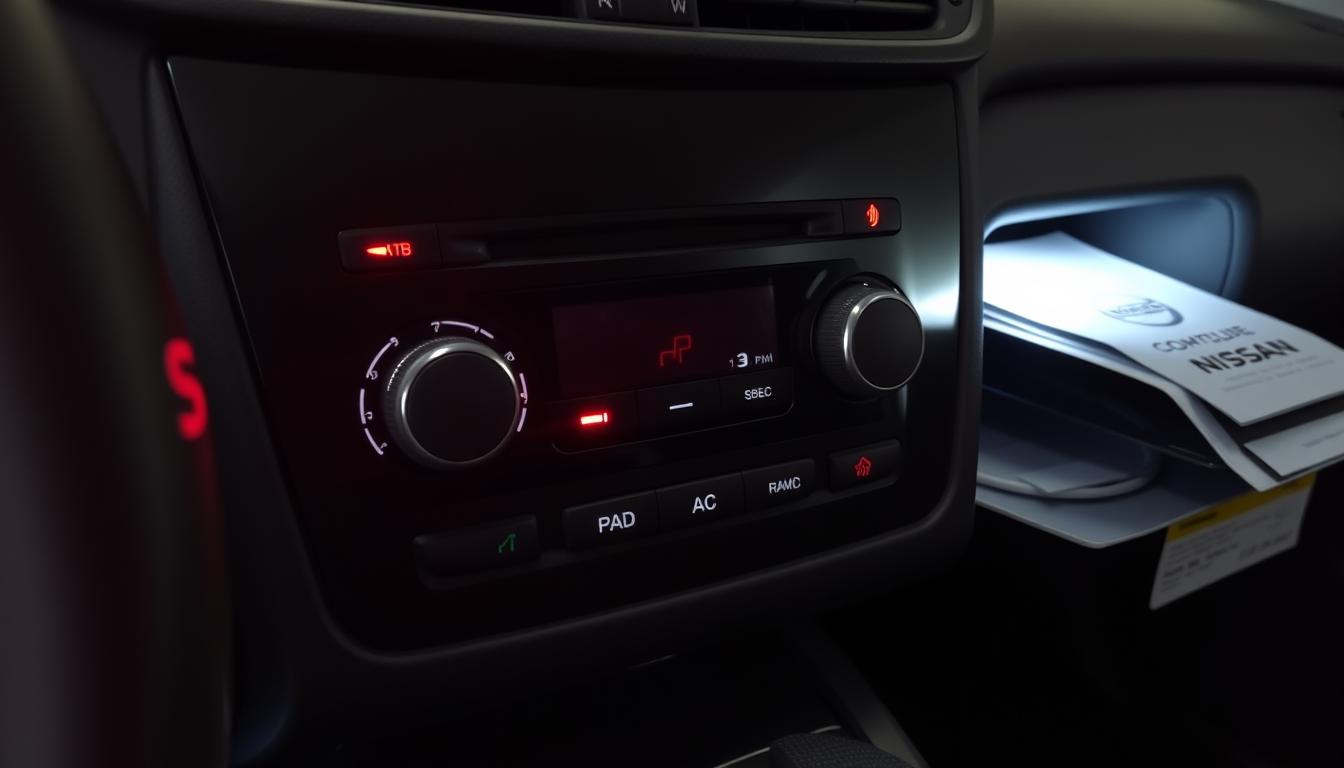Nissan Rogue owners often face climate control issues. These can make the cabin temperature uncomfortable. For example, the 2017 Nissan Rogue SV has had problems with its climate control system.
These problems can be expensive to fix, with some repairs costing $3000. Faulty temperature sensors and blend door actuators are common causes. Changing the entire HVAC box is sometimes needed, which can be very costly.
Many have shared their struggles with fixing these issues. Replacing the temp sensor and blend door actuator can help. But, it doesn’t always solve the problem.
The Nissan Rogue’s climate control system aims to make driving comfortable. But, when it breaks, it can be really frustrating. The system includes the HVAC box, temperature sensors, and blend door actuators.
Knowing how these parts work together is key to fixing problems. Faulty components and software glitches can cause issues. Regular maintenance can help avoid these problems.
Key Takeaways
- Nissan Rogue climate control problems can be costly to fix, with some repairs quoted at $3000.
- The Nissan Rogue HVAC issues can be attributed to various factors, including faulty temperature sensors and blend door actuators.
- Fixing the HVAC cabin temperature issues may involve changing the entire HVAC box.
- Understanding the components of the Nissan Rogue climate control system is crucial in identifying and fixing problems.
- The Nissan Rogue HVAC issues can be resolved by replacing the temp sensor and blend door actuator, but this may not always fix the problem.
- Regular maintenance can help prevent Nissan Rogue climate control problems.
Understanding Your Nissan Rogue Climate Control System
The Nissan Rogue’s climate control system keeps the inside of the car comfy. Knowing how it works helps fix any heating or cooling issues.
Basic Components Overview
The system has important parts like the compressor and the evaporator. The compressor makes the refrigerant work harder. The evaporator takes heat from the air. The condenser lets out the heat outside.
These parts work together to keep the car’s temperature right.
How the System Should Function
When everything’s working, the system cools or heats the air as you choose. The compressor moves the refrigerant around. The evaporator cools the air, and the condenser gets rid of the heat.
This makes sure the car stays at a steady temperature.
Common Control Panel Features
The control panel lets you change the temperature, fan speed, and air flow. You can make the air just right for you. This makes driving more comfortable.
| Component | Function |
|---|---|
| Compressor | Pressurizes the refrigerant for efficient cooling |
| Evaporator | Absorbs heat from the cabin air |
| Condenser | Releases absorbed heat outside the vehicle |
| Control Panel | Allows users to adjust temperature and airflow settings |
Most Common Nissan Rogue Climate Control Problems
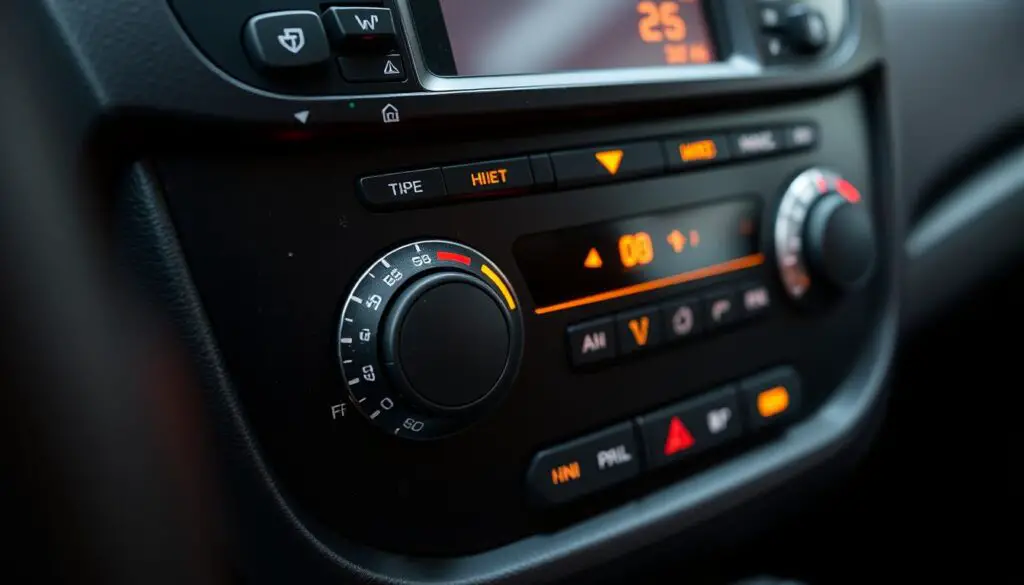
Many Nissan Rogue owners deal with climate control issues. One big problem is the Nissan Rogue AC not working. This can be due to low refrigerant or a broken compressor. It makes it hard to keep the car cool.
Another issue is the Nissan Rogue heater not blowing hot air. This might happen if the heater core or blower motor isn’t working right. It stops the car from heating up when it’s cold.
Some drivers also face problems with the temperature staying the same. This can be because of a bad thermostat or climate control sensor issues. Also, strange sounds from the system often mean a failing blower motor or loose parts in the HVAC system.
- AC not cooling effectively
- Heater fails to produce warm air
- Unstable cabin temperatures
- Unusual sounds from the climate system
| Problem | Possible Causes | Solutions |
|---|---|---|
| AC not working | Low refrigerant, faulty compressor | Recharge refrigerant, replace compressor |
| Heater not blowing hot air | Broken heater core, defective blower motor | Repair or replace heater core, fix blower motor |
| Inconsistent temperature | Faulty thermostat, climate control sensor issues | Replace thermostat, calibrate sensors |
| Strange noises | Failing blower motor, loose HVAC components | Inspect and replace blower motor, secure components |
Initial Diagnostic Steps for Climate Control Issues
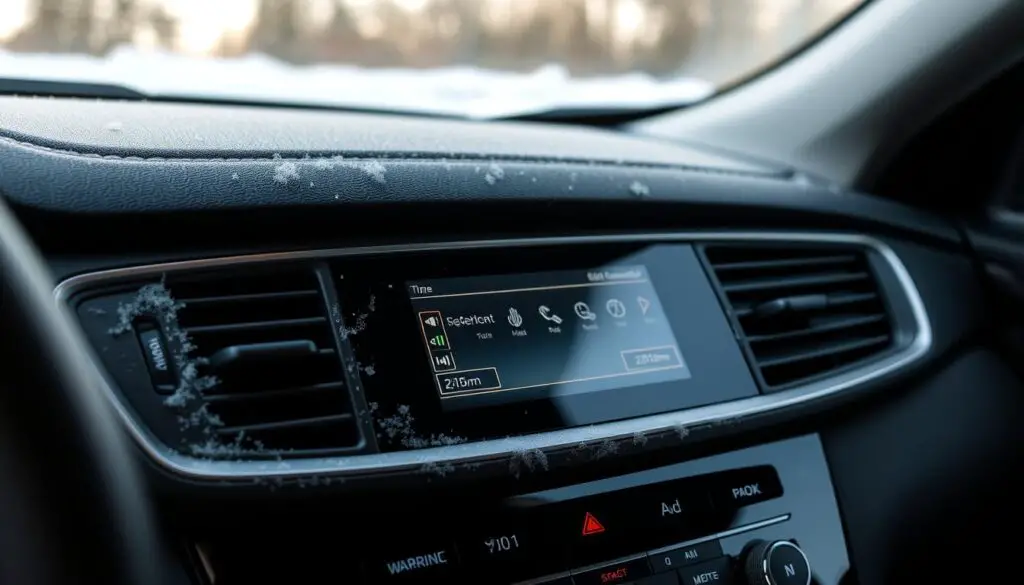
When your Nissan Rogue climate system fails, start by doing a detailed check to find the main problem. This step includes several important actions. They help find the issue before you start fixing it.
Visual Inspection Checklist
- Look for any refrigerant leaks around hoses and connections.
- Check the blower motor for damage or wear.
- Check the fuse box for blown fuses that affect the climate control.
- Make sure all electrical wires in the dashboard are connected.
System Response Testing
- Turn on the air conditioning and see if the compressor works.
- Change the temperature settings to see if the system responds right.
- Listen for any strange noises that might mean a part is broken.
- Make sure all vents are blowing air as they should.
Error Code Checking
Using an OBD-II scanner can show error codes that tell you what Nissan Rogue air conditioning troubleshooting you need. Here’s how to do it:
- Plug the scanner into the vehicle’s diagnostic port.
- Get and write down any error codes related to the climate control.
- Look up the codes in the vehicle’s manual or a professional guide.
- Fix the problems based on what the error codes say.
| Common Issue | Frequency |
|---|---|
| AC Refrigerant Leak | 37% |
| Climate Control Electrical Problem | 21% |
| AC Compressor Malfunction | 12% |
| Low Refrigerant Charge | 30% |
No Cool Air: Causes and Solutions
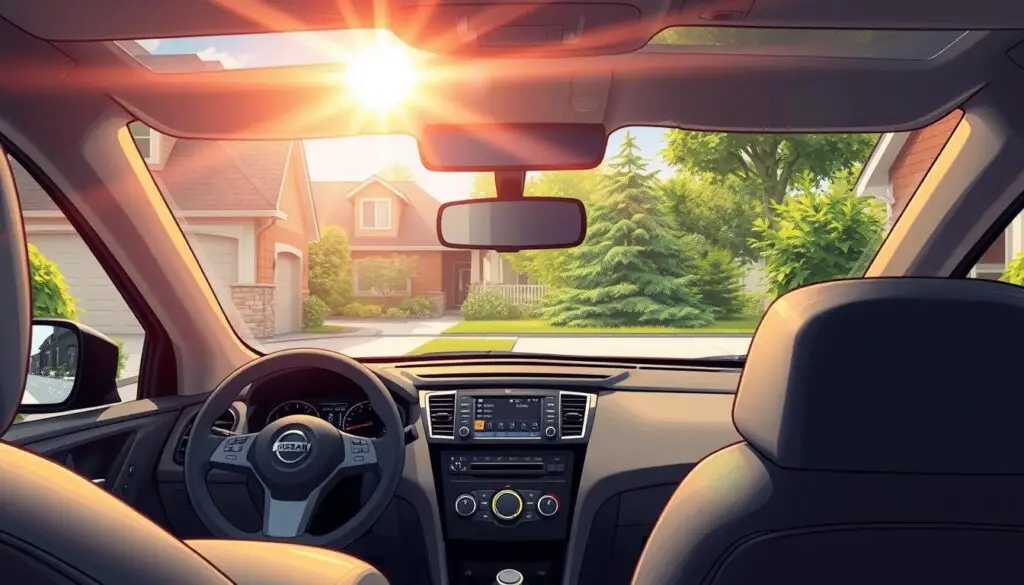
If your Nissan Rogue AC not working, there are several reasons why. Knowing these can help you fix the problem.
Low refrigerant levels are a common issue. Without enough refrigerant, the AC can’t cool the air well. You can often recharge it yourself with the right tools.
Compressor failure is another problem. The compressor moves refrigerant through the system. If it breaks, you’ll need a pro for Nissan Rogue climate control repair to fix or replace it.
Blocked condensers can also stop your AC from cooling. Dirt and debris can block airflow. Regular cleaning keeps the condenser working right.
Bad cooling fans are another issue. These fans help cool the condenser. If they’re not working, the AC can’t cool the air. You might need to replace or repair them.
For a visual guide, see the image below:
Fixing these problems quickly can make your Nissan Rogue comfortable again. If DIY fixes don’t work, get professional Nissan Rogue climate control repair to fix your AC right.
Heater Malfunction Troubleshooting
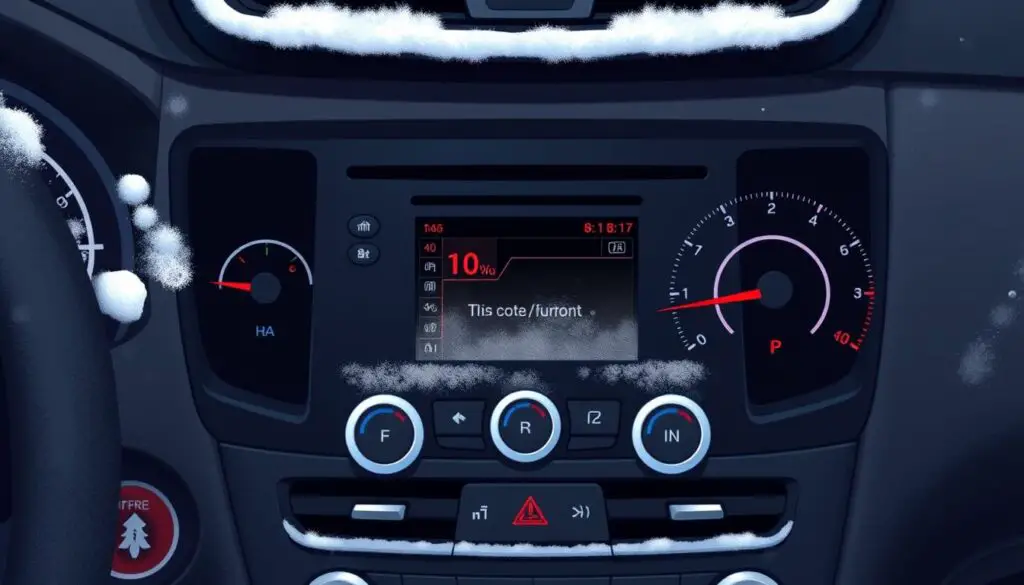
Having a Nissan Rogue heater not blowing hot air can be really frustrating, more so in cold weather. It’s important to know why Nissan Rogue heating and cooling problems happen to fix them.
Heating Core Issues
A clogged or leaking heating core is often the problem. If the heater core is blocked, it stops warm coolant from flowing. This means you won’t get enough heat. Replacing it can cost up to $3,000, as some users have found out.
Blower Motor Problems
The blower motor pushes air through the vents. If it’s not working right, you might get weak or no air at all. Fixing it usually costs about $500, including checking and possibly replacing it.
Temperature Sensor Failures
Bad temperature sensors can send wrong info to the climate control system. This messes up the heating. Finding and fixing a bad sensor is usually cheaper but very important for fixing the problem.
| Issue | Estimated Cost |
|---|---|
| Heater Core Replacement | $3,000 |
| Blower Motor Repair | $500 |
| Temperature Sensor Replacement | $200 |
If you keep having problems, you might need to talk to Nissan Consumer Affairs or the National Highway Traffic Safety Administration. Some owners have even thought about taking legal action because of these ongoing issues.
Electronic Control Module Complications
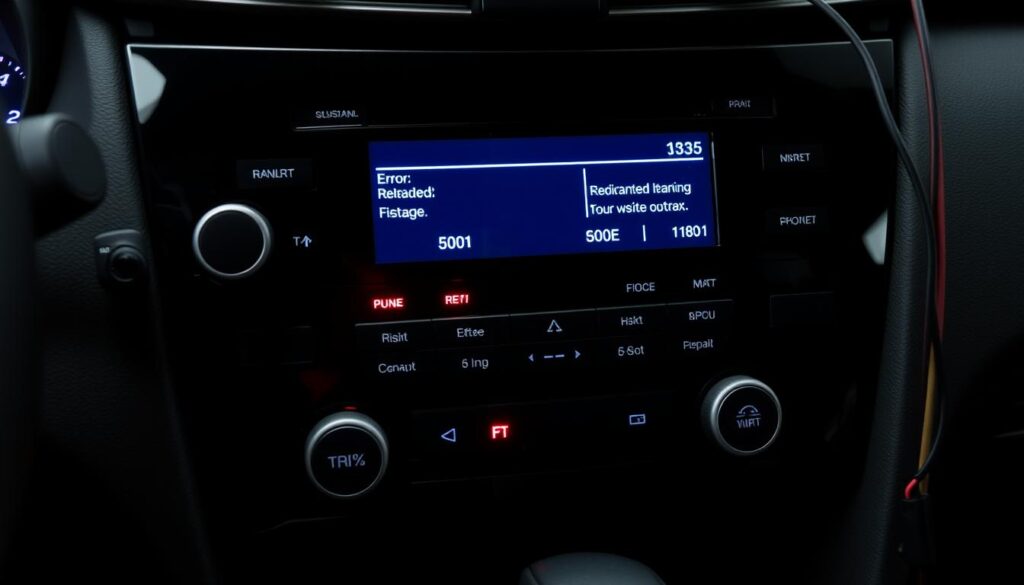
The Electronic Control Module (ECM) is key to your Nissan Rogue’s climate control. It controls the temperature and makes sure the system works well.
ECM problems can cause Nissan Rogue climate control problems. You might see odd temperature changes, controls that don’t work, or airflow that’s not steady.
- Erratic engine behavior affecting climate settings
- Reduced fuel efficiency linked to temperature control
- Failure to maintain set temperatures consistently
To find out if the ECM is the problem, follow these steps:
- Use an OBD II scanner to check for error codes related to the ECM.
- Inspect the wiring and connections for any visible damage.
- Perform an ECM reset to see if the issue persists.
If the ECM is faulty, you might need to reset it or replace it. Keeping up with maintenance and quick checks can stop big Nissan Rogue climate control problems. This keeps your car comfy and efficient.
Blower Motor and Fan Speed Problems
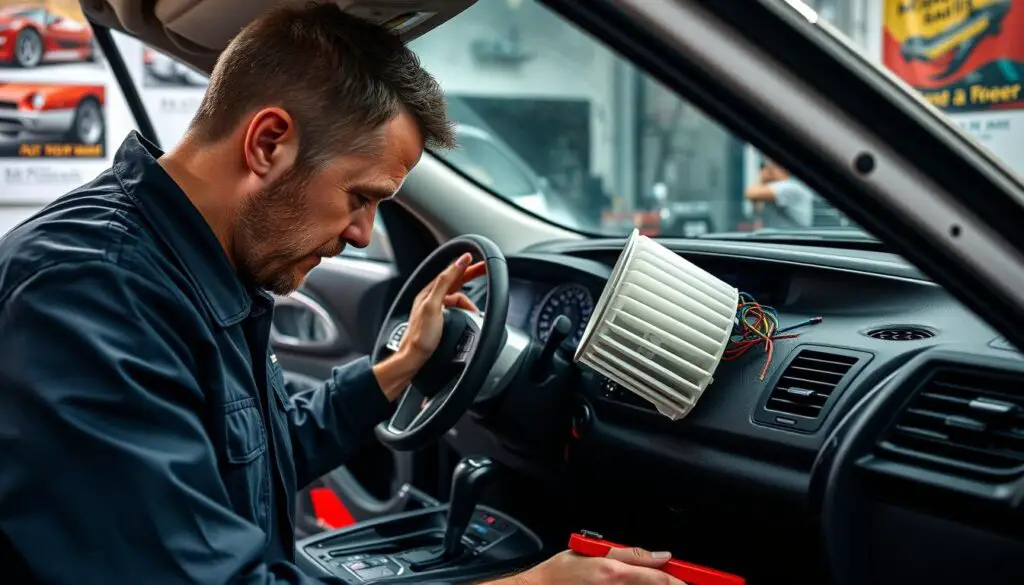
The blower motor is key for air circulation in your Nissan Rogue’s climate system. Knowing its role is crucial for fixing issues.
Common problems include worn brushes and a faulty resistor. These can affect air flow and fan speed. Fixing these issues quickly keeps your system running well.
Speed Control Issues
- Fan speeds not changing
- Unresponsive control panel
- Intermittent air flow
Motor Replacement Guide
- Disconnect the vehicle’s battery.
- Remove the glove box to access the blower motor housing.
- Unplug the electrical connector from the blower motor.
- Unscrew and remove the faulty blower motor.
- Install the new motor and secure it firmly.
- Reconnect the electrical connector and reassemble the glove box.
| Issue | Possible Cause | Solution |
|---|---|---|
| Fan speeds not changing | Faulty resistor | Replace the resistor |
| Unresponsive control panel | Blower motor failure | Replace the blower motor |
| Intermittent air flow | Worn motor brushes | Replace the blower motor |
Air Distribution and Vent Problems
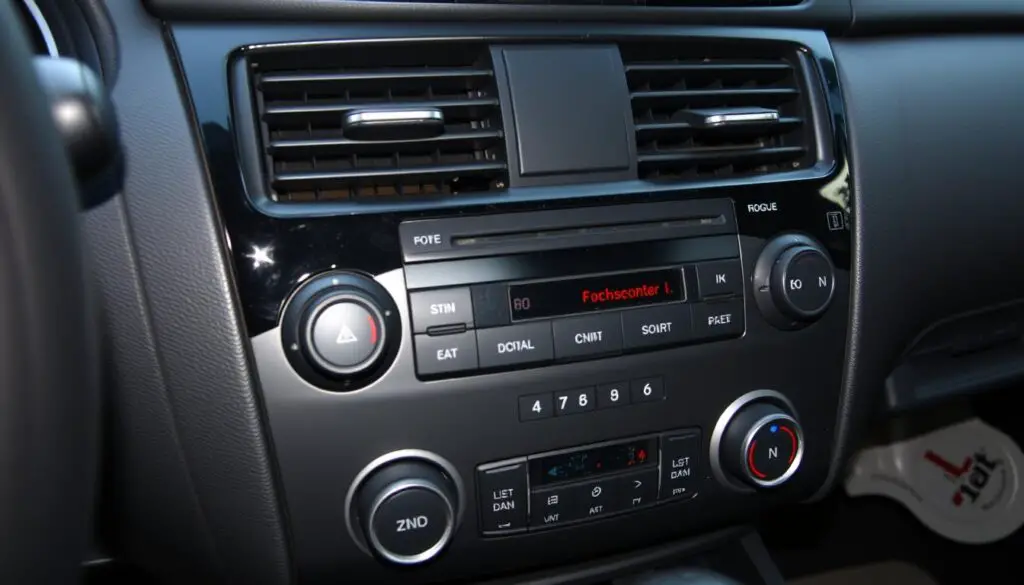
Feeling uneven airflow or hearing odd noises from your Nissan Rogue’s vents? It might mean your Nissan Rogue climate system is failing. Often, stuck blend doors are the culprit. These doors mix hot and cold air, but when they get stuck, the cabin’s temperature is off.
Clogged air ducts are another common issue. Dirt and debris can block the airflow. This makes it hard for the system to spread air evenly. Also, faulty actuators can mess up the air distribution by not moving right.
Notice any odd airflow or sudden temperature shifts? These signs might point to bigger problems than a simple fix can solve.
- Cleaning Vents: Remove dust and debris from air ducts to restore proper airflow.
- Inspecting Blend Doors: Ensure blend doors are moving freely without obstruction.
- Replacing Actuators: Faulty actuators may need replacement to regain control over air distribution.
| Year | Listings Available | Starting Price ($) |
|---|---|---|
| 2025 SV AWD | 9,163 | 16,514 |
| 2024 SV AWD | 26 | 20,349 |
| 2023 SV AWD | 246 | 16,800 |
| 2022 SV AWD | 50 | 16,994 |
| 2021 SV AWD | 123 | 11,500 |
Refrigerant-Related Issues and Solutions
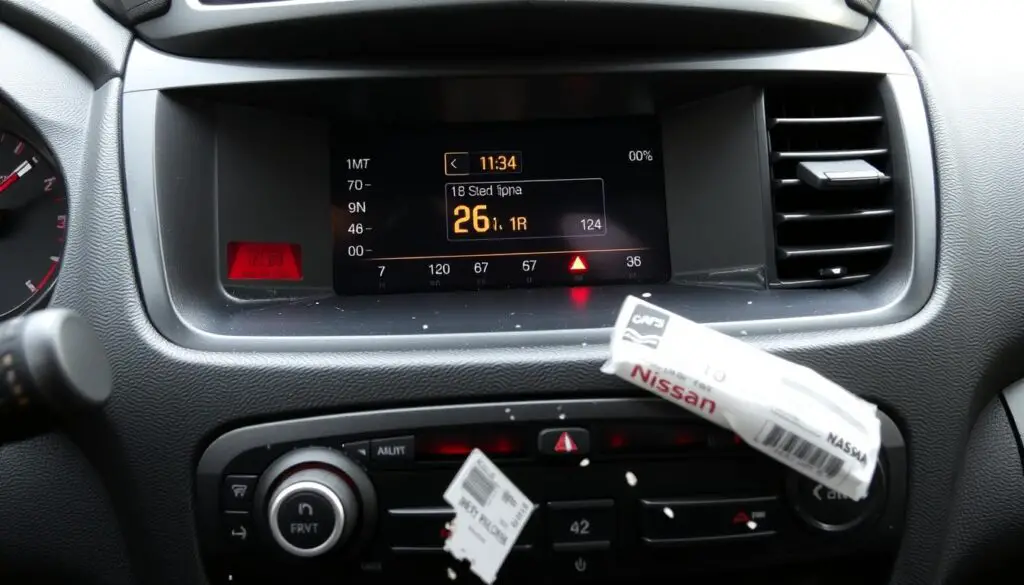
Low refrigerant levels can really hurt your Nissan Rogue’s AC. It makes the AC not work right. Keeping the right amount of refrigerant is key for good climate control.
Checking Refrigerant Levels
It’s important to check the refrigerant levels often. Low levels can make the AC blow warm air. Use a pressure gauge to check the refrigerant level accurately.
Leak Detection Methods
Finding leaks is key to fixing Nissan Rogue climate issues. Here are some good ways to do it:
- Look for oil residue around hoses and connections
- Use UV dye and a blacklight to find leaks
- Try electronic leak detectors for exact spots
Proper Recharge Procedures
Recharging the AC needs the right refrigerant for Nissan Rogue models. Here’s how to do it right:
- Use a recovery machine to remove old refrigerant
- Seal all leaks before adding new refrigerant
- Add refrigerant as the manufacturer says
- Test the system to make sure it works well
Keeping the right refrigerant levels stops Nissan Rogue climate problems. It makes driving more comfortable.
Regular Maintenance to Prevent Climate Control Problems
Regular maintenance can greatly reduce Nissan Rogue HVAC issues and Nissan Rogue heating and cooling problems. By sticking to a maintenance schedule, your climate control system stays efficient and reliable.
Filter Replacement Schedule
The cabin air filter is key for air quality and system performance. It’s best to replace it every 15,000 miles or once a year, whichever is sooner. A dirty filter can block airflow, making it tough for the HVAC to control temperature.
- Check the filter every 5,000 miles
- Replace it right away if it’s dirty
- Choose OEM or high-quality aftermarket filters for the best results
System Cleaning Guidelines
Cleaning climate control parts regularly stops buildup that can lead to Nissan Rogue heating and cooling problems. Pay special attention to the evaporator and condenser coils, which are vital for cooling.
- Clean the evaporator coils every 30,000 miles to remove mold and debris
- Make sure condenser coils are clear of leaves and dirt to keep airflow
- Use the right cleaning agents to avoid harming system parts
Also, check for refrigerant leaks and ensure all sensors work right to avoid big HVAC problems later.
When to Seek Professional Repair
If you’ve tried basic Nissan Rogue air conditioning troubleshooting and it didn’t work, it’s time to get professional help. Some problems, like refrigerant leaks or complex electrical issues, need special skills and tools.
- The AC is blowing warm air even after adding refrigerant.
- Unusual noises from the climate control system.
- Constant error codes related to the air conditioning.
- Visible leaks or damaged parts in the system.
Choosing a trusted repair shop is key for your Nissan Rogue climate control repair. Look for certified technicians with Nissan experience and good customer reviews. When picking a service, consider these points:
- Check their certifications and Nissan Rogue experience.
- Ask about part and labor warranties.
- Get an estimate before starting work.
Technicians will check the whole climate control system during a professional diagnosis. They’ll find the root cause and give a detailed repair plan. This includes checking refrigerant levels, inspecting electrical connections, and testing the system’s performance.
| Service | Cost | Customer Rating |
|---|---|---|
| AC Inspection | $111 | 8/10 |
| Parts Replacement | $16 | 8/10 |
| Labor | $95 | 8/10 |
Cost Considerations for Climate Control Repairs
It’s important to know the costs of Nissan Rogue climate control repair when planning your budget. Different factors affect the total cost. These include the specific problem and whether you fix it yourself or hire a professional.
Common Repair Expenses
Here are some common repairs for Nissan Rogue HVAC systems:
- Replacing the Compressor: Costs range from $500 to $1,200, based on parts and labor.
- Recharging the AC System: This usually costs $150 to $300.
- Fixing Electrical Issues: Prices vary, often between $200 and $700.
Some models might have HVAC air door actuator failures early, at 20,000 to 30,000 miles. This can lead to higher repair costs because of the complex nature of the repairs.
DIY vs Professional Service Costs
Deciding between DIY repairs and hiring a professional depends on your budget and skills:
- DIY Repairs: Starting costs might be lower for simple tasks like recharging the AC. But, complex repairs like replacing the compressor often need special tools and knowledge. This can lead to higher costs if done incorrectly.
- Professional Services: Professional Nissan Rogue HVAC issues repairs ensure quality and reliability. For example, an AC inspection averages $95 for labor alone, with parts costing extra.
Investing in professional repairs might be better in the long run, even if it costs more upfront. This is because it ensures reliability and safety, which are crucial, even in extreme climates.
Emergency Climate Control Fixes
Facing Nissan Rogue climate system failures can be stressful, even in extreme weather. Here are some quick steps to manage Nissan Rogue heating and cooling problems until you can get to a repair shop.
- In hot weather, park in shaded areas to keep the interior cooler.
- Use sunshades on windows to reduce heat buildup.
- If the AC stops working, turn off non-essential electronics to prevent battery drain.
- In cold weather, layer up and use the vehicle’s defrost settings to maintain visibility.
- Ensure proper ventilation by slightly opening a window to prevent system overheating.
Preventing further damage is key. For example, 10% of Nissan Rogues face climate control issues each year. Heater and AC system malfunctions make up 15% of these cases. This year, emergency SOS calls for climate fixes have jumped by 5%.
Issues with heated steering wheels and seats affect about 8% of models. And 20% of models use navigation systems to solve climate problems successfully.
| Issue | Occurrence Rate |
|---|---|
| Climate Control Failures | 10% |
| Heater/AC System Malfunctions | 15% |
| SOS Emergency Calls | 5% |
| Heated Steering Wheels/Seats Issues | 8% |
| Navigation System Resolutions | 20% Success |
Common Climate Control Error Codes Explained
Understanding error codes is key when dealing with Nissan Rogue climate control issues. These codes pinpoint specific problems in the system. This ensures repairs are accurate and timely.
What Each Code Means
| Error Code | Meaning | Possible Cause |
|---|---|---|
| P0010 | Camshaft Position Actuator Circuit | PCM failure or wiring issue |
| P0101 | Mass Air Flow Circuit | Faulty MAF sensor or vacuum leak |
| P0128 | Coolant Temperature Below Thermostat Regulating Temperature | Thermostat stuck open or low engine coolant |
Initial Response Steps
- Check the engine oil level and coolant levels.
- Inspect wiring and connectors for any visible damage.
- Use an OBD-II scanner to read and interpret error codes.
- Refer to the Nissan Rogue service manual for specific troubleshooting procedures.
- If unsure, consult a professional technician to diagnose and fix the issue.
Conclusion: Resolving Your Nissan Rogue Climate Control Issues
Fixing Nissan Rogue climate control problems is key for a comfy and safe drive. Regular Nissan Rogue air conditioning troubleshooting spots issues early, avoiding bigger problems. Knowing your climate control system helps with basic upkeep, like filter changes and refrigerant checks.
Dealing with ongoing issues like no cool air or heater problems? It’s important to know when to call a pro. Certified mechanics can find and fix complex issues. Keeping your Nissan Rogue’s climate control in check boosts comfort and car performance.
Be proactive with regular maintenance and quick action on warning signs. This keeps your climate control system running smoothly, making every drive pleasant. Taking these steps ensures reliable climate control and a longer life for your Nissan Rogue.
FAQ
Why is my Nissan Rogue’s AC not working?
Why is the heater in my Nissan Rogue not blowing hot air?
What are the most common climate control problems in the Nissan Rogue?
How can I diagnose climate control issues in my Nissan Rogue?
What should I do if my Nissan Rogue’s temperature control is malfunctioning?
What causes inconsistent temperature control in the Nissan Rogue?
How do I troubleshoot air conditioning problems in my Nissan Rogue?
When should I seek professional repair for my Nissan Rogue’s climate control system?
How much does it typically cost to repair climate control issues in a Nissan Rogue?
What maintenance steps can prevent climate control problems in my Nissan Rogue?
What do climate control error codes mean in the Nissan Rogue?
Can I perform DIY repairs on my Nissan Rogue’s HVAC system?
How do I fix blower motor and fan speed issues in my Nissan Rogue?
What emergency measures can I take if my Nissan Rogue’s climate control fails?
How do I handle refrigerant leaks in my Nissan Rogue’s climate control system?

Jack Thompson is a writer and seasoned auto mechanic with over 15 years of experience in the automotive industry. Known for his expertise in vehicle mechanics, Jack has a deep understanding of car and truck systems. His skills, honed through years of hands-on experience, have made him a trusted name in the field. Jack is committed to providing valuable insights into car maintenance and repair, helping vehicle owners keep their vehicles in top condition.

